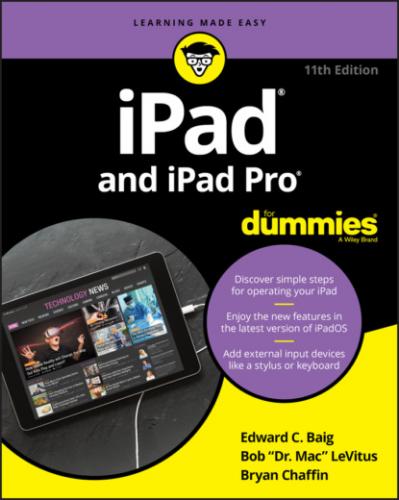We’d be remiss not to mention the even more useful Control Center, with controls for Wi-Fi, Bluetooth, audio playback, and more, all available from any screen in any app. You discover much more about Control Center in Chapter 14, but if you can’t stand the suspense, put your finger in the top-right corner of your iPad screen and swipe down to check out Control Center (and then tap the Home button or swipe up from the bottom to put it away).
Chapter 2
iPad Basic Training
IN THIS CHAPTER
By now you know that the iPad you hold in your hands is very different from other computers.
You also know that the iPad is rewriting the rule book for mainstream computing. How so? For starters, iPads don’t come with a mouse or any other kind of pointing device. They lack traditional computing ports or connectors, such as USB. And they have no physical or built-in keyboard, though Apple will sell you a Smart Keyboard accessory for recent iPad models.
iPads even differ from other so-called tablet PCs, some of which feature a pen or stylus and let you write in digital ink. As we point out (pun intended) in Chapter 1, the iPad relies on an input device that you always have with you: your finger. Okay, some iPads can use Apple Pencil and other styluses, but what makes an iPad so powerful is that a stylus is optional.
Tablet computers of one form or another have been around since the last century. They just never captured the fancy of Main Street. Apple’s very own Newton, an ill-fated 1990s personal digital assistant, barely made a dent in the market.
Technology — not to mention Apple itself — has come a long way since Newton. And tablets — led by the iPad brigade, of course — promise to become ever more prevalent, useful, and important.
If you own an iPhone, you already have a gigantic start in figuring out how to master the iPad multitouch method of navigating the interface with your fingers. If you’ve been using iOS 13, you have an even bigger head start. You have our permission to skim the rest of this chapter, but we urge you to stick around anyway because some aspects of iPadOS work in subtly different ways than on the iPhone. If you’re a total novice, don’t fret. Nothing about multitouch is painful.
Getting Started on Getting Started
You can set up your iPad with or without a Mac or PC. In Chapter 3, we show you how to set it up with a computer. But first, we show you how to set up your iPad without a computer.
Now, here are the two things you need to use your iPad:
An Apple ID account: You’ll want an account to download content from iTunes and the App Store, and to take advantage of iCloud, including iCloud backups. Read Chapter 7 for details on how to set up an account. Like most things Apple, the process isn’t difficult.
Internet access: Your iPad can connect to the Internet through Wi-Fi or cellular (if you bought an iPad with cellular capabilities). With Wi-Fi you can connect your iPad to cyberspace in your home, office, school, favorite coffeehouse, bookstore, or numerous other spots. If your iPad has cellular capabilities, you can connect anywhere.
In addition, if you want to back up your iPad to your Mac or PC, you will need one of the following:
A Mac running macOS Catalina 10.15 or later; use Finder to sync
A Mac running macOS El Capitan 10.11.6 through macOS Mojave 10.14.6 or later; use iTunes 12.8 or later to sync
A Windows PC running Windows 7 or later; use iTunes 12.10 or later to sync
You can go to www.itunes.com/download to fetch a copy of iTunes. Or launch your current version of iTunes and then choose iTunes ⇒ Check for Updates.
A Closer Look at Cellular Data on Your iPad
Wireless technology is constantly evolving, but support for cellular capabilities on mobile devices is everyday stuff now. You need to pay for a cellular plan with a carrier to use your iPad’s cellular capabilities. Read on to learn more about your cellular options.
Figuring out how much data you need beforehand isn’t always easy, but it’s simple enough to adjust along the way. If you’re streaming a lot of music, T-Mobile for one provides a nice benefit: the capability to stream free on most major services, including Spotify and Apple Music.
The following are some of the offerings from the major US carriers when we published this book. But prices and the amount of data you get change so fast, you’ll want to check current offerings and promotions. Also, in some instances, you must pay activation or other fees:
AT&T: Starting at $50 a month for 10GB
Sprint: Starting at $35 a month for 10GB
T-Mobile: Starting at $10 a month for 2GB
Verizon: Starting at $20 a month for 2GB
A friendly warning pops up on your iPad when you get close to your limit. At that point, you can pay more to add to your data bucket or start from scratch next month. And, as noted, prices are subject to change.
iPads with cellular service may include an Apple SIM card that theoretically allows you to bounce from one carrier to another. The process isn’t always simple, however, because such SIM cards are sometimes locked down, either by Apple or by the carrier from which you buy the tablet. Moreover, the type of SIM card inside your iPad varies. Some models have nano-SIM cards. Others, including most early models dating all the way back to the original iPad, have a micro-SIM card. More recent models have both an embedded Apple SIM card and a tray for a nano-SIM card.
If
